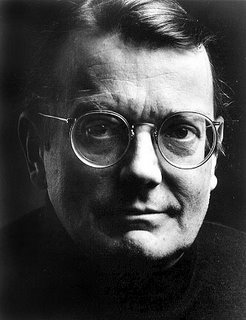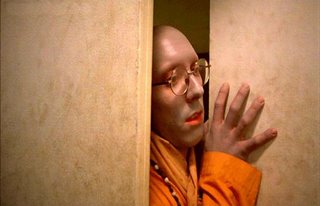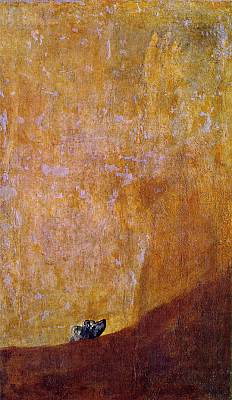 Afternoons in Madrid linger with me some five years on. My belly full of odd meat gelatins (or some pork curio from the Musee de Jambon with its walls of waxed pig legs) and that treacly pull-tab wine made effervescent and poppy with fizzy water, I would move my buzz over to the Prado and plunk myself down in front of the paintings of Francisco de Goya. (Not that it's the only thing there; aside from Hieronymus Bosch's "Garden of Earthly Delights" the Prado has a titillating amount of holy pictures depicting virgin teet milk squirting across otherwise normal biblical scenes). In the main collection are his most acceptable works (like "The Naked Maja" and "Third of May 1808"), rendered during his time as a favorite of the Spanish court, with sketches of bull fights and quotidian life in Spain, or else works gleaned on linoleum or lithograph. There is not yet a medium that Goya worked in that I did not find infused with humanity in every form, the flashes of beauty and brutality tucked masterfully into the actions of the everyday.
Afternoons in Madrid linger with me some five years on. My belly full of odd meat gelatins (or some pork curio from the Musee de Jambon with its walls of waxed pig legs) and that treacly pull-tab wine made effervescent and poppy with fizzy water, I would move my buzz over to the Prado and plunk myself down in front of the paintings of Francisco de Goya. (Not that it's the only thing there; aside from Hieronymus Bosch's "Garden of Earthly Delights" the Prado has a titillating amount of holy pictures depicting virgin teet milk squirting across otherwise normal biblical scenes). In the main collection are his most acceptable works (like "The Naked Maja" and "Third of May 1808"), rendered during his time as a favorite of the Spanish court, with sketches of bull fights and quotidian life in Spain, or else works gleaned on linoleum or lithograph. There is not yet a medium that Goya worked in that I did not find infused with humanity in every form, the flashes of beauty and brutality tucked masterfully into the actions of the everyday.And yet nothing holds the gravity as the gallery that contains the entirety of his "penturas negras." Works rendered on the plaster walls of his 'Quinta del sordo' (Goya was deaf due to an illness) as the man neared the end of his mortal coil, I would sit in front of these untitled monstrosities for upwards of thirty minutes per panel, plunging into the void beneath the veneer of oil paint, suspended in equal parts awe, disgust, and terror at Goya's visions. Now an octogenarian, fed up and repulsed by the thin veil of society, he reveals the death that the social conspiracy always seeks to hide: faces cannot mask their skulls, landscapes are in fact purgatories and prisons, destruction of the other is the main impetus of man's life. Earlier on, Goya tempered such latent facts with buffoonery, but there's no time left for buffeting. The body is but another carcass to devour for dinner, man can only be a cannibal in the end. Chronos is hungry; it's either eat or be eaten, munchacho.
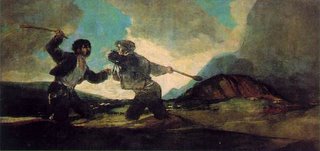 In these black paintings, Goya most readily ascends to his place as the father of modern art. Such unflinching depictions still resonate in the present. Embroiled in a fight with my best friend at the time, the paintings of fighting cats and the one of two men hacking each other apart with cudgels are disturbing and ever-relevant, an existential precursor to a Monty Python skit. These ghastly paintings are almost always tempered, edited outside of the walls though: the long wide painting of a witches' coven in almost every art book is cropped so as to leave out the immense black goat-headed idol that the huddled women orbit in devout worship, reproductions of a dog helpless in quicksand never quite captures the astounding texture of the amber backdrop.
In these black paintings, Goya most readily ascends to his place as the father of modern art. Such unflinching depictions still resonate in the present. Embroiled in a fight with my best friend at the time, the paintings of fighting cats and the one of two men hacking each other apart with cudgels are disturbing and ever-relevant, an existential precursor to a Monty Python skit. These ghastly paintings are almost always tempered, edited outside of the walls though: the long wide painting of a witches' coven in almost every art book is cropped so as to leave out the immense black goat-headed idol that the huddled women orbit in devout worship, reproductions of a dog helpless in quicksand never quite captures the astounding texture of the amber backdrop.I was wrong to think these the final looks at the beyond though, as a recent exhibit at the Fricke reveals what happened next with Goya. As Republicans took over the government, a bloody clearing out of liberals soon followed. Artists, thinkers, dissenters and opponents not butchered outright fled to France so as to avoid the bloodshed. Forced to leave 'quinta del sordo,' Goya settled in Bordeaux country, where he continued to document the darkness that swirls around the living.
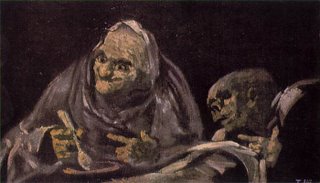 The sketches here are rendered in layers of black crayon quickly and with a master's ability to shorten time with a few quick strokes. Hazy sooty clouds obliterate subjects, seeking to return to oblivion, and the white figures captured on the paper only temporarily contrast and escape their grip. These figures in an indeterminate field have hideous, demonic faces swarm around them. The crayon rubs are gone over by a finer tip, elucidating faces and features that would otherwise be hidden and occult. Even the classical painted portraits once predominant in his oeuvre are rendered with only a few dark colors. Amid such obsolescence, these faces glow, fight back, flicker brightly against the oppressive, endless night. There are sketches of sanitarium inhabitants truly beset by devils and lunacy, but even quarreling domestic couples are surrounded on all sides by demons, witches; madness can come at any moment.
The sketches here are rendered in layers of black crayon quickly and with a master's ability to shorten time with a few quick strokes. Hazy sooty clouds obliterate subjects, seeking to return to oblivion, and the white figures captured on the paper only temporarily contrast and escape their grip. These figures in an indeterminate field have hideous, demonic faces swarm around them. The crayon rubs are gone over by a finer tip, elucidating faces and features that would otherwise be hidden and occult. Even the classical painted portraits once predominant in his oeuvre are rendered with only a few dark colors. Amid such obsolescence, these faces glow, fight back, flicker brightly against the oppressive, endless night. There are sketches of sanitarium inhabitants truly beset by devils and lunacy, but even quarreling domestic couples are surrounded on all sides by demons, witches; madness can come at any moment. There's no better medium for him by this late stage than that of blackened ivory plates, a clutch of these tiny tiles the highlight of the exhibit. A layer of sooty ink coating them, Goya employs a small brush that doubles as a razor, cutting away blackness and bullfights so as to set about re-revealing the whiteness that also resides underneath the black. Almost every face is Lon Chaney-esque. The resulting portraits epitomize his endgame, the temporal face of every man but a white skull lasting till the end of time, the captured flesh just a blackened memory.

